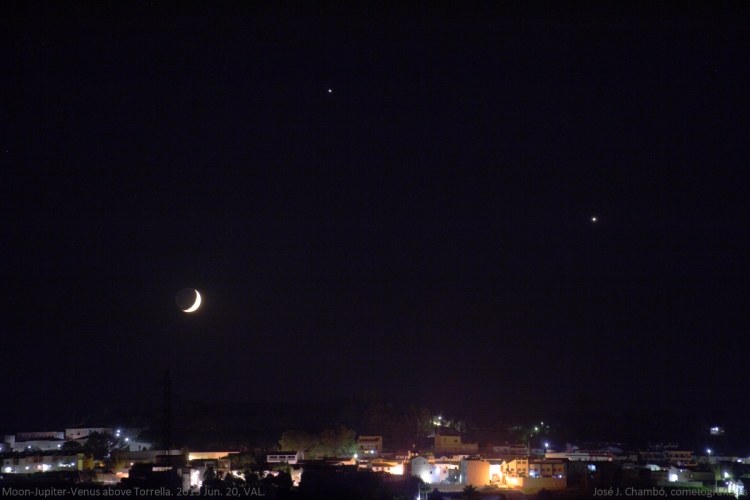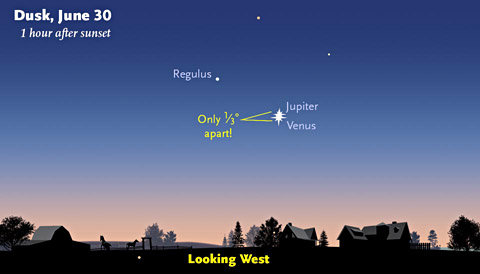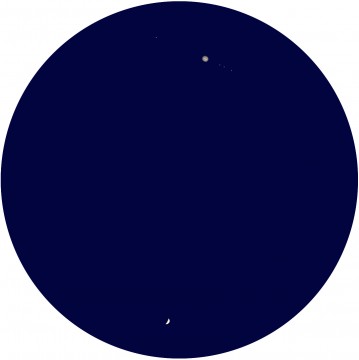The two brightest planets are gliding closer together in the early evening sky, and their celestial dance culminates with an ultra-close pairing on June 30th.
Anyone who pays even cursory attention to the evening sky has surely noticed that the two brightest planets, Venus and Jupiter, have been drawing closer together in the west in the evening twilight. At the beginning of June, the two planets were 20° apart in the sky, about twice the width of your fist held at arm's length. Week by week, Jupiter and the stars behind it have gradually slipped lower in the evening twilight. But Venus, due to its rapid orbital motion around the Sun, has stayed high up.

José J. Chambó Bris
The resulting slow-motion convergence is setting the stage for a dramatic sky sight. The warm-up act came on June 19th and 20th, when the planetary duo was joined by a thin and lovely crescent Moon. Farther to their upper left, and fainter, was Regulus, the alpha star of Leo. (I was texting all my friends: "Go outside. Now. Look west!")
But now the spectacle is taking an even more dramatic turn — one you just can't miss. For eight nights beginning June 27th, these two bright planets will be within 2° of each other — close enough to cover both with the thumb of an outstretched hand. In the midst of that weeklong run, on June 30th, Venus and Jupiter will appear so close together — just 1/3° apart — that they'll look like a tight, brilliant double star in the evening sky. You'll be able to cover both with the tip of an outstretched pinky finger. Amazing stuff!
Surely, this spectacle must be some kind of omen. Well, yes, it's a sign from the heavens to get outside and look! As my S&T colleague Alan MacRobert points out, a spectacular conjunction like this often gets people started in our wonderful pastime. "These planetary groupings in the sky have no effect on Earth or human affairs — except for one," he says. "They can lift our attention away from our own little world into the enormous things beyond. That's what amateur astronomers do all the time."

Sky & Telescope diagram
In fact, such conjunctions, or close pairings, of these two planets are not particularly rare. The orbit of Venus is tipped just 3.4° with respect to Earth's, Jupiter even less at 1.3°. So these close conjunctions are destined to occur. For example, the two appeared slightly closer together (though not as high up) before dawn last August 18th, and they'll be separated by about 1° before dawn on the morning of October 26th.
Sky & Telescope Contributing Editor Fred Schaaf brings up a very interesting point: this current trio of Venus-Jupiter conjunctions closely resembles a similar series in 3-2 BC that has been suggested as the Star of Bethlehem. "As has been the case in 2014–15," he explains, "the first two conjunctions back then were extremely close, the last one separated by about 1°, all three occurred not far from Regulus, and all were similarly high up in the sky."

Source: Stellarium
Have a telescope or binoculars handy on June 30th. Both planets will crowd into the same telescopic field of view, Venus appearing as a fat crescent and round Jupiter accompanied by its four largest moons. The two planets will appear nearly the same size — but Jupiter, though much larger in reality, is also much farther away. On the 30th Venus is 49 million miles (78 million km) from Earth, and Jupiter is more than 10 times farther out at 564 million miles (908 million km). Their globes will also contrast dramatically in brightness, with Venus's crescent appearing dazzlingly white compared to Jupiter's duller, striped cloud deck.
And be sure to take pictures! Share your best shots with other S&T.com visitors by posting them in our Online Photo Gallery.
For a comprehensive guide to upcoming sky events, one that S&T's editors use every day, get the indispensable RASC Observer's Handbook 2015.
 6
6
Comments
Graham-Wolf
June 28, 2015 at 10:37 pm
Closing in closer to each other each day. And... such a wonderful naked eye sight in the evening twilight, here in Lower Hutt, New Zealand. We've even had a "three-way" conjunction, with the First Quater Moon getting into the act. Three for the price of two. So, get out those digicameras and start clicking, folks! Try ISO 400, lens wide open and say 1s, 2s, 5s (bracketed)... the Goldilocks method. And, good luck.
Had a quick peek at 67p the other day.... low 14th Magnitude. Even at high power, could not see Philae. And, I don't think it could see me, either.
Best wishes:- Graham W. Wolf, Barber Grove Observatory (BGO), New Zealand.
You must be logged in to post a comment.
ctj
June 29, 2015 at 8:40 pm
arrrgh, enough with the "star of bethlehem." the modern consensus appears to be that it was trendy back then to believe a new star appeared in the sky every time someone was born, and early christians obviously wanted the star for an "important" person to be important too.
You must be logged in to post a comment.
Monmouth Astro
June 30, 2015 at 3:38 am
Jupiter and Venus were also very close together last August but few people noticed because they would have had to get up early to see them. Thus the cranks claiming this event hasn't happened for 2000 years are way off. My picture from the 18th August is at: https://www.flickr.com/photos/imagined_horizons/14768526380/in/album-72157619757740169/ Last time, Venus was the upper one.
You must be logged in to post a comment.
Peter Wilson
June 30, 2015 at 12:52 pm
In today's world, some citified, non-reader of Sky&Tel could look out west tonight and declare, "OMG! There's a new star!" That is the premise of the suggestion that the planetary conjunction of 3-2 BC was mistaken for a new star, the Star of Bethlehem. The implication is that these ancient "experts"--the Magi who advised kings and queens, based on observed motions in the heavens--were so ignorant as to not see this slow-motion conjunction coming, and mistook it for a new star.
The Magi may have been confused about the astrological implications of the heavenly goings-on, but it is impossible they could have "confused" a planetary convergence with a new star. The suggestion is made to denigrate Christianity, by portraying its witnesses as ignorant simpletons.
A SN did appear about 6 BC. While somewhat problematic for the timeline, there were no birth records back then, and it is at least plausible, as it does not reduce the Magi to befuddled ignorami.
You must be logged in to post a comment.
Graham-Wolf
June 30, 2015 at 10:40 pm
Wow!
The two planets really closed up last night, here in the Hutt Valley, NZ. A lot of locals walking around the streets at twilight tea time looking up out over the Western skies.
Good luck to Alan Stern and the hard working "New Horizons" team, for 11:50 UT July 14th. Less than a fortnight to go to Pluto rendevous. My own personal bold predictions?
1. The number of Pluto satellites will at least double to 10.
2. Two of the largest features on Pluto will be named after Lowell, and Tombaugh.
3. We'll increase our knowledge of Pluto, at least 5 fold.
4. "New Horizons" will make it safely through it's convoluted trajectory without damage.
5. Photos will exceed all expectations.
6. At Pluto-gee, image resultions will be in the order of 1km or less, (after digi-massaging).
7. Data will safely transmit back to Earth over the next 2 years or so.
8. Telemetary signals will continue another 5 years or so. The probe will still be phoning home in 2020!
We'll see how far off may predictions are.
"New Horizons" will turn out soon, to be the "little mouse that really roared"!
Graham W. Wolf:- Lower Hutt, New Zealand.
You must be logged in to post a comment.
Dobsonion
July 1, 2015 at 11:30 am
I was able to get a short video of the conjunction, battling wind/storms/clouds. It captures the view through a telescope.
https://vimeo.com/132289433
Brian D. Ottum, Ph.D.
Michigan (scope in the desert)
You must be logged in to post a comment.
You must be logged in to post a comment.